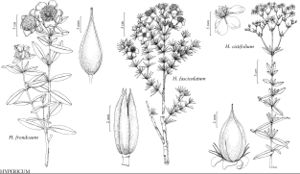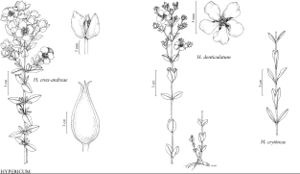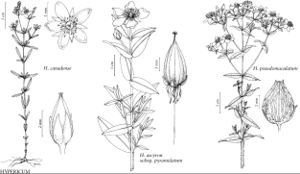Hypericum
Sp. Pl. 2: 783. 1753.
Gen. Pl. ed. 5, 341. 1754.
Herbs, annual or perennial, subshrubs, or shrubs [trees], sometimes rhizomatous, glabrous or hairy, with glandular canals, lacunae, or dots containing resins or waxes (amber), essential oils (pale, translucent), and/or, sometimes, hypericin and pseudohypericin (black or red) in various parts. Stems: internodes terete (not lined) or 2-lined, 4-lined, or 6-lined at first (lines usually raised), then sometimes becoming angled, terete, or winged; bark smooth or striate, sometimes corky, punctiform. Inflorescences terminal, cymose, 2+-flowered, or flowers solitary, branching stellate [cupulate]; sepals persistent or deciduous, (3–) 4–5, distinct or ± connate, margins sometimes glandular-ciliate; petals persistent or deciduous, (3–) 4–5 [–6], contorted, yellow to orange, sometimes red-tinged; stamens persistent or deciduous, (5–) 10–300 (–650), in continuous or interrupted ring or in (3–) 4–5 fascicles, fascicles distinct or connate, each with 1–60+ stamens; filaments distinct or basally connate; anthers yellow to orange, oblong to ellipsoid, almost isodiametric, sometimes with amber or black gland on connective; staminode fascicles 0 [3]; ovary 2–5-merous; placentation axile to parietal; ovules 2+ on each placenta; styles distinct or ± connate basally, spreading to ± appressed. Capsules 2–5-valved, sometimes with glandular vittae or vesicles. Seeds narrowly cylindric to ellipsoid, sometimes carinate; testa foveolate or reticulate to scalariform [papillose]. x = 12, 9–7, 6 (dihaploid).
Distribution
Nearly worldwide
Discussion
Species ca. 490 (54 in the flora).
Shrubs with deciduous leaves, petals, and stamens belong to either Hypericum sect. Ascyreia Choisy (with five stamen fascicles and five styles) or sect. Androsaemum (Duhamel) Godron (with five stamen fascicles and three or four styles). These are all introductions, mostly garden escapes. Those in sect. Ascyreia include: Hypericum calycinum Linnaeus, a low shrub with creeping stolons and flowers 50–95 mm diam. that has been found in California, Oregon, and Washington; H. ×moserianum Luquet ex André, its hybrid with H. patulum Thunberg, a low (sterile?) branching shrub with red anthers; and H. hookerianum Wight & Arnott, a shrub to 2 m tall with narrow leaves and a dense ring of relatively short stamens, recorded from California (its identity requires confirmation). In sect. Androsaemum, H. androsaemum is a deciduous shrub with relatively small flowers and baccate fruits that ripen from cherry-red to black; it has been found in British Columbia and in California and Washington.
Introduced herbaceous species with three stamen fascicles and three styles include: Hypericum hirsutum, with hairy stems and leaves (Ontario); H. tetrapterum, with four-winged internodes and lanceolate sepals (British Columbia and Washington); H. pulchrum with cordate leaves and red-tinged petals (Newfoundland, St. Pierre and Miquelon); and H. humifusum Linnaeus, a procumbent herb with unequal sepals (British Columbia).
Selected References
Lower Taxa
Key
| 1 | Herbs, subshrubs, or shrubs, black glands absent; stamens in continuous or interrupted ring or in 4 or 5 barely discernable fascicles, each of 1 or 2 stamens | > 2 |
| 1 | Herbs or shrubs, black and/or red glands usually present throughout, sometimes absent; stamens in 5 fascicles, each of 2+ stamens | > 3 |
| 2 | Herbs (perennial), subshrubs, or shrubs; petals deciduous; stamens usually persistent, sometimes deciduous, 30–650, in continuous ring or in 4–5 barely discernable fascicles; styles ± appressed, bases distinct. | Hypericum sect. Myriandra |
| 2 | Herbs (annual or perennial); petals persistent; stamens persistent, (5–)10–80, usually in continuous or interrupted ring, sometimes in 5 barely discernable fascicles; styles ± spreading, bases distinct. | Hypericum informal sect. group Brathys |
| 3 | Shrubs; leaves deciduous (base articulated); style bases distinct. | Hypericum sect. Webbia |
| 3 | Herbs (perennial); leaves persistent or tardily deciduous (base not articulated) or; style bases ± connate or distinct | > 4 |
| 4 | Herbs, black glands absent; flowers 40–70 mm diam.; stamens 150, in 5 fascicles, fascicles usually distinct, rarely 1 pair connate; styles ± appressed, bases ± connate or distinct. | Hypericum sect. Roscyna |
| 4 | Herbs, black glands usually on leaves, sepals, and petals and, sometimes, on stems and anthers; flowers 6–35 mm diam.; stamens 20–109, in 5 fascicles, fascicles connate (as 2 + 2 + 1); styles spreading, bases distinct. | Hypericum informal sect. group Hypericum |


